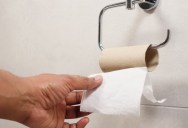Why Rolls Of Toilet Paper Are Smaller Than They Used To Be

I feel like we’ve never talked about rolls of toilet paper as often as we have since 2020, when it was shockingly hard to come by.
Seriously, that was one thing I never would have imagined I would take for granted.
Now, though, people are noticing the roll are getting smaller.
Is it shrinkflation, like everything else, or is there another explanation?
Toilet paper used to come in 650-sheet packages, but now, a regular roll of Charmin contains just 56 sheets per roll.
In the 1970’s, Charmin’s regular roll had 650 single-ply sheets, but that shrunk to 500 in 1975, and then 400 in 1979.

Mark Dent at The Hustle says that was far from the end of things, though.
“Charmin was far from done. By 1986, the sheet count had dropped to 380. On eBay, I found nearly identical 1988 Charmin packages – one contained 300 single ply sheets per roll and the other had 280.”
Not only that, but the sheets are smaller than they used to be.
In 1966, a regular roll was made up of square sheets of 4.5 inches a side. Today, they’re just 3.92-by-4 inches.
Prices, on the other hand, have increased by 700% per square foot.
It’s not just Charmin, either, according to Edgar Dworsky of ConsumerWorld.org. Even Scott 1000’s standard four-pack has decreased from 32.2 ounces to 23.6 ounces.
TTO-BMA, two companies that track, forecast, and analyze the wood pulp market, verify there is nothing driving rising costs of a roll of toilet paper.
That said, ever since the 1980s, the price of toilet paper has been volatile. People blame the emergence of China as a global superpower and also climate change, both of which can affect the wood pulp market.
Toilet paper brands in other countries, like in the UK, experience a lot less fluctuation in price, though, so these don’t seem to totally explain what’s going on in the States.

Dent says this is at least partly because Americans want “softer” wood pulp that can cost more per roll – 30% instead of just 10% soft wood pulp in other countries.
Americans also have a “higher expectation for strength…they won’t even change the supplier of their softwood if they can help it.”
The bottom line is, of course, that Americans demands are leading to the destruction of ecologically important areas around the world.
“Now, more than ever, it is clear that the impacts of manufacturing single-use tissue products from forest fiber are not only severe but also avoidable.”
The Natural Resources Defense Council’s 2023 report addresses this issue as well.
“Companies know that there are more responsible ways to create tissue products than using forest fiber – namely, using recycled materials and responsibly sourced alternative fibers – and many have already embraced these solutions in their product lines. Yet the largest, most powerful tissue companies have failed to adopt these more sustainable sourcing practices. Instead they remain entrenched in a destructive ‘tree-to-toilet’ pipeline’ model that continues to come at an extreme cost to Indigenous communities, the climate, threatened species, and forests like the boreal in Canada.”

More brands have started to offer sustainable toilet tissue products in response to consumer demand for sustainable products.
If you want to follow this trend of caring about the environment, though, you’ll likely have to switch brands; the three largest in the US make their tissue almost exclusively from forest fiber.
That said, consumers do have power to influence change, if enough of us can get on the same page.
So go ahead and petition Charmin, Bounty, and the like to add sustainable options for those who want them, or ask you store managers to stock sustainable choices.
If we buy them, they will almost certainly make more of them.
Hopefully the ship will turn in time to avoid the iceberg.
Thought that was fascinating? Here’s another story you might like: Why You’ll Never See A Great White Shark In An Aquarium

Sign up to get our BEST stories of the week straight to your inbox.




